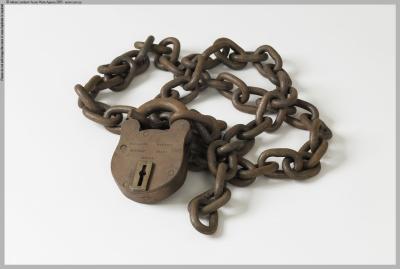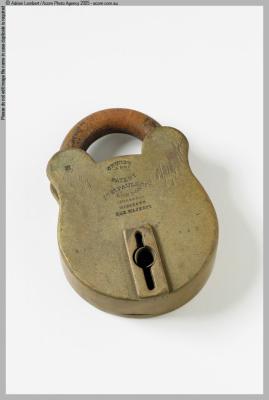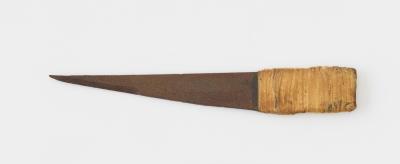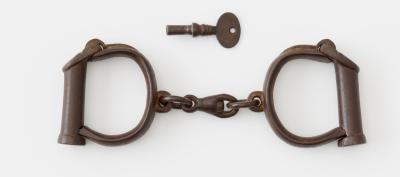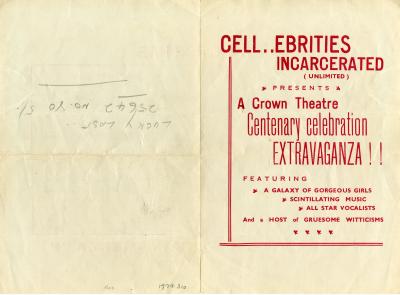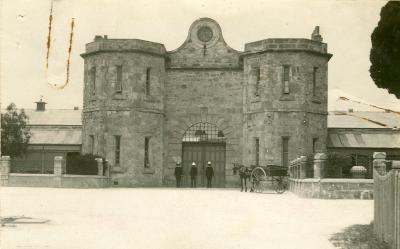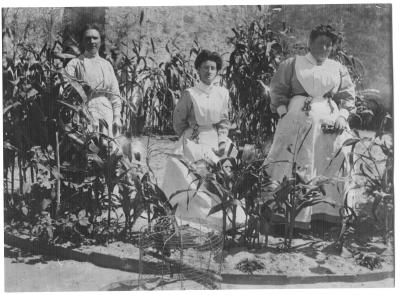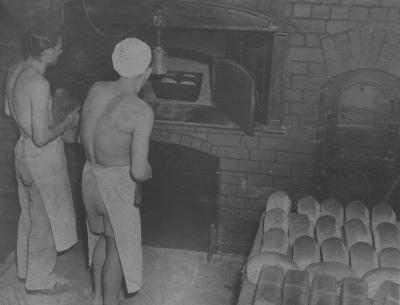PADLOCK
c. 1820 - 1829Large, metal, shield shaped, Chubb padlock. Large, heavy metal body, with a wide, rounded bottom edge, with curves inwards towards the middle, before flaring outwards into two small, semicircular protrusions at the top. Spanning in a circular ark above these protrusions is a thick, metal band, which locks into position. On the front of the padlock is a small, rectangular metal plate, which slides upwards to reveal a keyhole. The padlock is in the locked position, and the key is missing. Imprinted on the front of padlock near the top is the royal British crest, with a lion and a unicorn holding a shield. Underneath the crest is imprinted, 'BY APPOINTMENT TO/ H.M. THE KING'. Imprinted on the surface of the keyhole cover is a circular logo with a fish in the centre, surrounded by the words, 'CHUBB/ LONDON'. Imprinted on the padlock to the right of the keyhole is, 'F5437'.
This padlock can be dated to approximately the mid to late 1820s. The stamp on the padlock, ' BY APPOINTMENT TO / H.M THE KING', indicates it was produced before Queen Victoria became queen in 1837. The serial number F5437 indicates it was made during Chubb's earlier operations. This early date of manufacture suggests this padlock may have come to Fremantle onboard a convict vessel, and was in use at Fremantle Prison since the first half of the nineteenth century.
Details
Details
'CHUBB/ LONDON'
Locks have existed, in some form or another, for millennia. Forms of security have developed as societies spread, and with these changes, locks themselves have evolved. One of the most revolutionary changes was the invention of the padlock. At the root of this device is its portability; the idea that a lock can be added to something and then removed again. Padlocks are a detachable lock that fastens and secures with the use of a ‘shackle’. The shackle can be a hinge or slide, with the assistance of a spring, but it is the fact that once open it can be removed that makes a padlock superior.
Security at the Convict Establishment was originally controlled by Western Australia's first Comptroller-General of Convicts, Edmund Henderson, who administered the Convict Establishment for thirteen years. The primary responsibilities of the Comptroller-General were to direct convict labour, and control convict discipline. This included security measures, for both those inside the Establishment, and those out on work parties. As part of this system of control, the padlock was an essential tool, as it could be implemented where needed, and used away from the Prison site.
A selection of padlocks in the Fremantle Prison Collection can be accurately dated to the convict era via their markers marks and serial numbers. Most locks had some form of identifying mark affixed to them during manufacturing. Most of the padlocks in the Fremantle Prison Collection where made by Chubb, the premier locksmiths in the United Kingdom, who also carried the Royal Appointment seal. This lock (1996.70.1), is stamped, “BY APPONTMENT TO H.M. THE KING”. Combined with the serial number F5437, this dates the manufacture of this padlock to the mid to late 1820s.
Most of the padlocks in the Fremantle Prison Collection where left on site when the Prison closed in 1991.
Padlocks are emblematic of the prison system, with high interpretive potential and social significance as easily recognizable forms of imprisonment and control. This collection of padlocks also has high historic significance, dating from the earliest time of transportation to Western Australia. By providing a direct link between the early period of convictism in WA, and the Outstanding Universal Value from which Fremantle Prison claims its World Heritage Listing, the collection of padlocks in the Fremantle Prison Collection have international significance.
